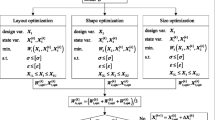Abstract
This paper discusses the problem of structural optimization of product families with predefined platforms. The main challenge lies in the increased design variables and constraints, and providing an optimal tradeoff for individual products performance in the family which are competitive with each other. The Concurrent Subspace Optimization for multidisciplinary problem is extended to product family design with predefined platforms. The main advantage of the proposed approach is that the system level owns the ability to catch the global tendency of the true design space and the number of evaluations required is reduced by using surrogate models. Each subspace optimization problem has the freedom to specify the unique variables for one family member, and the system level optimizes the product platform using the surrogate models created based on subspace optimizations. The process is solved in an iterative way, and the improving surrogate models guide the optimization to the global optimal design. Results from a truss family example with small design space confirm the ability and efficiency of the extended Concurrent Subspace Optimization to address product family problem by compared with ATC approach. Then the proposed method is successfully applied to a family of unmanned aircraft wing structures, which is more complicated and related to practical implementation issues.






Similar content being viewed by others
References
Allison J, Roth B, Kokkolaras M (2006) Aircraft family design using decomposition-based methods. Proceedings of the 11th AIAA/ISSMO Multidisciplinary Analysis and Optimization Conference
Bates SJ, Sienz J, Toropov VV (2004) Formulation of the optimal Latin hypercube design of experiments using a permutation genetic algorithm. Proceedings of the 45th AIAA/ASME/ASCE/AHS/ASC Structures, Structural Dynamics and Materials Conference
Dai ZH, Scott MJ (2006) Effective product family design using preference aggregation. J Mech Design 128(4)
Fellini R, Panos P, Weber T et al. (2000) Application of a product platform design process to automotive powertrains. Proceedings of the 8th AIAA/NASA/USAF/ISSMO Symposium on Multidisciplinary Analysis and Optimization
Fellini R, Kokkolaras M, Michelena N et al. (2004) A sensitivity-based commonality strategy for family products of mild variation, with application to automotive body structures. Struct Multidisc Optim 27(1–2)
Fellini R, Kokkolaras M, Papalambros PY (2006) Quantitative platform selection in optimal design of product families, with application to automotive engine design. J Eng Design 17(5)
Fujita K, Amaya H, Akai R (2013) Mathematical model for simultaneous design of module commonalization and supply chain configuration toward global product family. J Intell Manuf 24(5)
Huang CH, Galuski J, Bloebaum CL (2007) Multi-objective Pareto concurrent subspace optimization for multidisciplinary design. AIAA J 45(8):1894–1906
Jiao J, Simpson T W, Siddique Z (2007) Product family design and platform-based product development: a state-of-the-art review. J Intell Manuf 18(1)
Kokkolaras M, Fellini R, Kim HM et al. (2002) Extension of the target cascading formulation to the design of product families. Struct Multidisc Optim 24(4)
McCormick BW (1995) Aerodynamics, aeronautics, and flight mechanics. Vol. 2. New York: Wiley
Messac A, Martinez MP, Simpson TW (2002) Effective product family design using physical programming. Eng Optimiz 34(3)
Meyer MH, Lehnerd AP (1997) The power of product platforms. Free Press, New York
Muffatto M (1999) Introducing a platform strategy in product development. Int J Prod Econ 60–61
Nelson SA, Parkinson MB, Papalambros PY (2001) Multicriteria optimization in product platform design. J Mech Design 123(2)
Öman M (2011) Optimization and robustness of structural product families. Linköping University
Öman M, Nilsson L (2010) Structural optimization of product families subjected to multiple crash load cases. Struct Multidisc Optim 41(5)
Öman M, Nilsson L (2012) An improved critical constraint method for structural optimization of product families. Struct Multidiscip Optim 45(2):235–246
Pate DJ, Patterson MD, German BJ (2012) Optimizing families of reconfigurable aircraft for multiple missions. J Aircraft 49(6)
Roth B (2008) Aircraft family design using enhanced collaborative optimization. Stanford University
Roth B, Kroo I (2008) Enhanced collaborative optimization. 12th AIAA/ISSMO Multidisciplinary Analysis and Optimization Conference, Victoria
Sellar RS, Batill SM, Renaud JE (1996) Response surface based, concurrent subspace optimization for multidisciplinary system design. AIAA paper 714
Simpson TW (2004) Product platform design and customization: status and promise. Ai Edam 18(1)
Simpson TW, Maier J, Mistree F (2001) Product platform design: method and application. Res Eng Des 13(1)
Simpson TW, Siddique Z, Jiao JR (2006) Product platform and product family design. Springer US
Simpson TW, Jiao JR, Siddique Z et al (2014) Advances in product family and product platform design. Springer, New York
Sobieszczanski-Sobieski J (1988) Optimization by decomposition: a step from hierarchic to non-hierarchic systems. NASA Technical Report CP-3031
Sobieszczanski-Sobieski J (1990) Sensitivity of complex, internally coupled systems. AIAA J 28(1):153–160
Tosserams S, Etman LFP, Rooda JE (2008) Augmented Lagrangian coordination for distributed optimal design in MDO. Int J Numer Methods Eng 73(13):1885–1910
Wujek BA, Renaud JE, Batill SM et al (1996) Concurrent subspace optimization using design variable sharing in a distributed computing environment. Concurr Eng 4(4):361–377
Yong MP (2008) Design optimization method for modular platform-based aircraft family. Nanjing University of Aeronautics and Astronautics, Nanjing
Author information
Authors and Affiliations
Corresponding author
Rights and permissions
About this article
Cite this article
Zou, J., Yao, WX. & Xia, TX. Extension of concurrent subspace optimization to structural optimization of product families. Struct Multidisc Optim 52, 281–291 (2015). https://doi.org/10.1007/s00158-015-1242-z
Received:
Revised:
Accepted:
Published:
Issue Date:
DOI: https://doi.org/10.1007/s00158-015-1242-z




